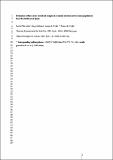Por favor, use este identificador para citar o enlazar a este item:
http://hdl.handle.net/10261/77670COMPARTIR / EXPORTAR:
 SHARE SHARE
 CORE
BASE CORE
BASE
|
|
| Visualizar otros formatos: MARC | Dublin Core | RDF | ORE | MODS | METS | DIDL | DATACITE | |

| Título: | Evaluation of three cycles of full-sib reciprocal recurrent selection in two maize populations from the Northeast of Spain |
Autor: | Peña-Asín, Javier CSIC; Álvarez Rodríguez, Ángel CSIC; Ordás Pérez, Amando CSIC ORCID ; Ordás López, Bernardo CSIC ORCID | Palabras clave: | selection, maize Combining ability Breeding reciprocal recurrent Zea mays L. |
Fecha de publicación: | may-2013 | Editor: | Springer Nature | Citación: | Peña-Asín J, Álvarez A, Ordás A, Ordás B. Evaluation of three cycles of full-sib reciprocal recurrent selection in two maize populations from the Northeast of Spain. Euphytica 191 (2): 301-310 (2013) | Resumen: | In Europe a heterotic pattern commonly used in maize breeding is “American Dent × European Flint”. Maize breeding programs generally use only a small portion of the useful genetic variability present in the local open-pollinated varieties which, otherwise, have a poor performance that hampers their use. Two maize composites, EZS33 formed by open-pollinated flint varieties from dry or Mediterranean Spain, and EZS34 from USA dent populations, were developed in Zaragoza (Spain). Both were subjected to three cycles of full-sib reciprocal recurrent selection (RRS) for yield. The objective of our study was to evaluate after three cycles of selection the effect of RRS. The selection significantly increased yield in the population crosses (3.0 % per cycle) and in the crosses of the populations with testers of different origin. The correlated responses for the population crosses in other agronomic traits like flowering and early vigor were in the desired direction, but plant height was reduced. We propose that stover yield or related traits could be included in selection programs as selection criteria to prevent their decline. The adapted population increased the frequency of favorable alleles for yield, but the inbreeding depression counteracted their effect on the mean. RRS had a positive effect on other traits. According to our data, RRS can be useful to develop improved populations from which it would be possible to develop lines with improved both specific and general combining ability with different heterotic groups. We conclude that the heterotic pattern “Mediterranean Spain × US Dent” is potentially very useful for maize breeding for adaptation to Mediterranean conditions and an interesting source of cultivars for low-input agriculture. | Descripción: | 15 Pags., 4 Tabls. | Versión del editor: | http://dx.doi.org/10.1007/s10681-012-0856-0 | URI: | http://hdl.handle.net/10261/77670 | DOI: | 10.1007/s10681-012-0856-0 | ISSN: | 0014-2336 | E-ISSN: | 1573-5060 |
| Aparece en las colecciones: | (EEAD) Artículos (MBG) Artículos |
Ficheros en este ítem:
| Fichero | Descripción | Tamaño | Formato | |
|---|---|---|---|---|
| PeñaJ_Euphytica_2013.pdf | 449,8 kB | Adobe PDF |  Visualizar/Abrir |
CORE Recommender
SCOPUSTM
Citations
7
checked on 28-abr-2024
WEB OF SCIENCETM
Citations
5
checked on 28-feb-2024
Page view(s)
413
checked on 04-may-2024
Download(s)
337
checked on 04-may-2024
Google ScholarTM
Check
Altmetric
Altmetric
NOTA: Los ítems de Digital.CSIC están protegidos por copyright, con todos los derechos reservados, a menos que se indique lo contrario.
